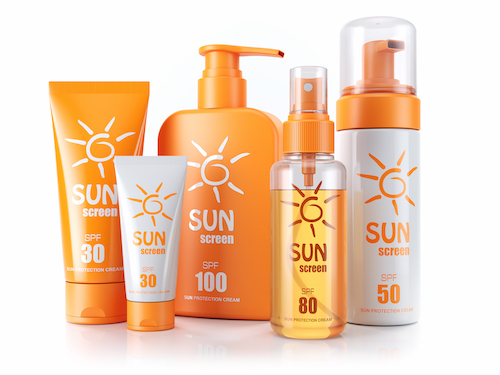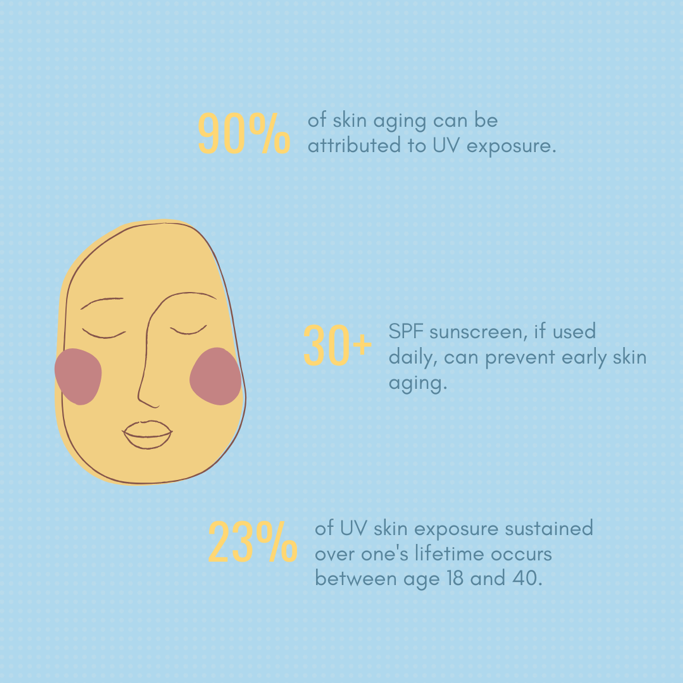Skin Protection Rules of Thumb
- If your shadow is short, you should seek shade. Your shadow can help you tell the altitude of the sun. A short shadow means the sun is at its peak and UV rays are at their most intense.
- UV are strongest between 10 am-4 pm. Make sure you are using extra sun protection when out during these times.
- No sunscreen is waterproof. Even water-resistant sunscreen needs to be reapplied at least every 80 minutes.
- Most people use too little sunscreen. Use at least 1 ounce of sunscreen to cover all exposed skin. For reference, a golf-ball weighs an ounce.
- Dark, tightly woven fabric offers the best UPF. A white t-shirt only provides ultraviolet protection factor (UPF) of 7 and this decreases to only UPF 3 when wet.
- Sun protection is important year round. Cloudy and cold days can still have intense UV exposure.
- Regardless of skin tone, UV rays can still cause skin damage and increase risks of skin cancer.
- Makeup does not always provide enough UV protection. Apply at least one tablespoon of SPF 30+ sunscreen on your face prior to applying makeup.
- Keep infants under 6 months of age out of direct sunlight, or cover with clothing rather than sunscreen if possible.
- There are two different kinds of sunscreen: chemical and mineral. Chemical sunscreen sinks into the skin and absorbs UV rays. Mineral sunscreen sits on top of the skin and reflects UV rays.
- You can begin to burn within minutes of being out in the sun unprotected.
- Be careful when spending time in the sun near cement, snow, or water, as UV rays can be reflected off these surfaces.
All About Sunscreen
-
Q: What type of sunscreen should I use?
-
A: The American Cancer Society recommends that you choose a sunscreen with “broad spectrum” protection, which measn that it protects against both UVA and UVB rays. All sunscreen products protect against UVB rays, which are the main cause of sunburn and skin cancers, but UVA rays also contribute to skin cancer and premature aging. Only products that pass a certain test can be labeled “broad spectrum.
Make sure your sunscreen has a sun protection factor (SPF) 30 or higher. The SPF number is the level of protection the sunscreen provides against UVB rays. Higher SPF numbers do mean more protection, but the higher you go, the smaller the difference becomes.
-
-
Q: How do I protect myself from the sun if I’m allergic to sunscreen?
-
A: The most common reaction to sunscreen is called "contact dermatitis" and occurs in people who have a sensitivity to an ingredient found in sunscreen or cosmetics with a sunscreen component. A rarer reaction is "photocontact dermatitis", or a "photoallergy". This type of reaction usually occurs where the product has been applied to the body and exposed to sunlight, since for some people there is an interaction between a sunscreen ingredient and ultraviolet light which leads to a skin reaction.
Most reactions from sunscreen are due to an allergy to the active ingredients, but it can also be due to a reaction to the fragrances or preservatives in the product. It's recommended to see a dermatologist to diagnose any reaction and help determine which ingredients should be avoided in the future. Short term, sunscreens that use ingredients such as zinc oxide and titanium dioxide are not known to cause irritation on skin. You can also check for sunscreen specifically formulated for people with allergies or sensitive skin.
-
-
Q: Does sunscreen expire?
-
A: Sunscreen does lose its strength after time, so it is important to keep an eye out for bottles that have the expiration date listed. Do not use sunscreen that is past its expiration date. If the sunscreen bottle does not have an expiration date listed, make sure to write the date you bought the sunscreen somewhere on the bottle, as the FDA requires that all sunscreens require their original strength for at least three years.
-
-
Q: What are the differences between each sunscreen SPF?
-
Rutgers Cancer Institute's Dr. Roman Groisberg talks sunscreen and UV protection all summer long.
-
-
Q: Will having a "base tan" help protect my skin from UV rays?
-
There is a common misconception that having a base tan will help protect your skin from getting burned, but that is not the case. Since any kind of tan on its own is evidence of skin damage due to UV rays, having a base tan will not do anything to prevent further damage from occurring. The only way to prevent sun damage to skin is to regularly apply sunscreen with high SPF, keep skin covered in the sun, or avoid direct sunlight entirely during the times of day when the rays are strongest.
-
Skin Cancer Prevention
Rutgers Cancer Institute’s Dr. Roman Groisberg reminds us about skin cancer prevention tips for summer.
Test your sun safety knowledge with the following interactive quizzes:
The American Cancer Society: What's your sun safety IQ?
The American Adacemy of Dermatology asks: Can you spot skin cancer?
The Skin Cancer Foundation Blog: How Much Do You Know About Skin Cancer?
Additional Resources
- Sun Safety
- Excessive Sun Exposure: Just Say No
- Sun Safety: Planning is Your Best Protection
- Being Sun Smart
- $3M Grant Supports Expansion of Digital Intervention for Skin Self Examination among Skin Cancer Survivors
- How Common is Skin Cancer? And More Questions You’re Afraid to Ask
- Exploring Sun Protection Behaviors Among U.S. Hispanic Outdoor Workers
- American Academy of Dermatology:
- David Cornfield Melanoma Fund:
- Melanoma Research Foundation
- US Food and Drug Administration


